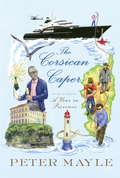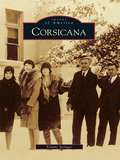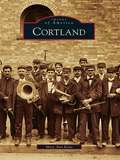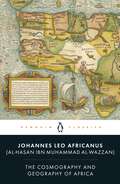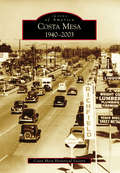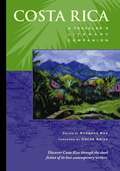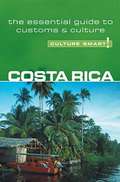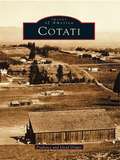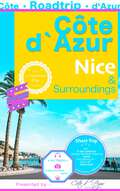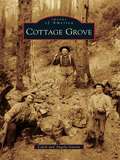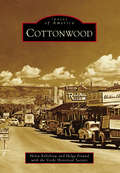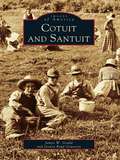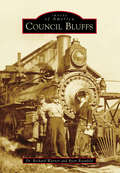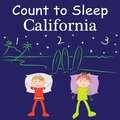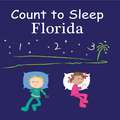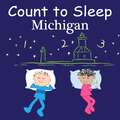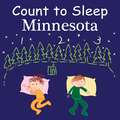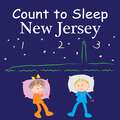- Table View
- List View
The Corsican Caper: A novel
by Peter MayleHere is Peter Mayle at his effervescent best--his master sleuth, Sam Levitt, eating, drinking, and romancing his way through the South of France even as he investigates a case of deadly intrigue among the Riviera's jet set. Billionaire Francis Reboul is taking in the view at his coastal estate, awaiting the arrival of vacationing friends Sam Levitt and Elena Morales, when he spies a massive yacht whose passengers seem a little too interested in his property. The yacht belongs to rapacious Russian tycoon Oleg Vronsky, who, for his own purposes, will stop at nothing to obtain Reboul's villa. When Reboul refuses to sell, Vronsky's methods quickly turn unsavory. Now it's up to Sam--he's saved Reboul's neck before--to negotiate with an underworld of mercenaries and hit men, not to mention the Corsican mafia, to prevent his friend from becoming a victim of Vronsky's "Russian diplomacy." The dire situation doesn't stop Sam and Elena from attending glamorous fêtes where the wines and starlets alike sparkle, and enjoying sumptuous meals--from multicourse revelations to understated delights like the first asparagus of the season, on which one must make a wish. But as Sam's sleuthing draws him closer to the truth of Vronsky's schemes, he realizes Reboul might not be the only one unable to enjoy the good life for long. Brimming with entertaining twists, sparkling scenery, and mouthwatering gustatory interludes as only Peter Mayle can write them, The Corsican Caper is a one-way ticket to pleasure, Provençal style.From the Hardcover edition.
Corsicana
by Dr Tommy StringerThe first Texas legislature created Navarro County in 1846 and named it in honor of Texas patriot Jose Antonio Navarro. When asked to name the new seat of government, Navarro replied, "Call it Corsicana for the island of Corsica, the birthplace of my father." From its beginnings in 1848, Corsicana's history has been marked by Texas icons such as cotton, cattle, and chili. The town's history took a dramatic turn when drillers looking for water struck oil instead in 1894. By the end of the decade, more than 500 wells dotted the landscape, marking the first commercial oil field in Texas and launching the industry that has become synonymous with the Lone Star State. Oil, business enterprises, and politics are important parts of Corsicana's legacy, but much of its history is found in the everyday events that make up the fabric of a community. Local history is filled with stories of people who overcame obstacles to fulfill the American Dream.
Cortland
by Mary Ann KaneWhen Cortland was incorporated as a village in 1853, its population was mainly transplanted New Englanders and Irish immigrants, and it encompassed territory 1 mile from east to west. By 1871, two rail lines crossed the village, and their cargos of coal encouraged the development of industries, particularly carriages and sleighs. The 1890s brought Cortland's first urban renewal with industrialists replacing wooden mansions with ones of brick, stone, and Queen Anne designs. The 20th century opened with full employment in industries that not only served the country but also the world. This encouraged Italians, Ukrainians, and Lebanese to settle in Cortland and share their heritage. Photographs from the archives of the Cortland County Historical Society illustrate how life was lived in Cortland before the 21st century.
The Cosmography and Geography of Africa
by Leo AfricanusThe first new translation in over 400 years of one of the great works of the RenaissanceIn 1518, al-Hasan ibn Muhammad al-Wazzan, a Moroccan diplomat, was seized by pirates while travelling in the Mediterranean. Brought before Pope Leo X, he was persuaded to convert to Christianity, in the process taking the name Johannes Leo Africanus. Acclaimed in the papal court for his learning, Leo would in time write his masterpiece, The Cosmography and the Geography of Africa.The Cosmography was the first book about Africa, and the first book written by a modern African, to reach print. It would remain central to the European understanding of Africa for over 300 years, with its descriptions of lands, cities and peoples giving a singular vision of the vast continent: its urban bustle and rural desolation, its culture, commerce and warfare, its magical herbs and strange animals.Yet it is not a mere catalogue of the exotic: Leo also invited his readers to acknowledge the similarity and relevance of these lands to the time and place they knew. For this reason, The Cosmography and Geography of Africa remains significant to our understanding not only of Africa, but of the world and how we perceive it. Translated by Anthony Ossa-Richardson and Richard Oosterhoff
Costa Mesa: 1940-2003 (Images of America)
by Costa Mesa Historical SocietyPerhaps no one could have foreseen the amazing transformation of Costa Mesa from a sleepy rancho to today's bustling "City of the Arts." Along with other Orange County cities, Costa Mesa experienced explosive growth, redevelopment, county bankruptcy, traffic, and environmental issues. While navigating these events, Costa Mesa emerged with its own brand of Southern California cityhood. World War II brought the Santa Ana Army Air Base (SAAAB) to town, along with 125,000 cadets. Postwar SAAAB conversion established the Orange County Fairgrounds, colleges, and housing. After incorporation in 1953, the race was on to achieve critical mass while surrounded by older, established cities. The Segerstrom family led the way to world-class facilities, such as South Coast Plaza and the Orange County Performing Arts Center. These venues shifted the city center from the traditional downtown to north Costa Mesa. Located at the confluence of three freeways and adjacent to John Wayne-Orange County Airport, Costa Mesa faces the future as the center of the South Coast Metro complex.
Costa Rica
by Oscar Arias Barbara RasJourney into the Costa Rican imagination through twenty-six remarkable stories, selected and organized regionally for the curious traveler. Here, for the first time in English, the best of Costa Rica's writers conjure the country's allure and vitality, its coffee fields and palm groves, cicadas and songbirds, shrouded mountains and blazing savannas, while telling stories unique to Costa Rican life. Contributors include Alfredo Aguilar, Fernando Durán Ayanegui, Alfonso Chase, Quince Duncan, Fabián Dobles, Louis Ducoudray, Carlos Luis Fallas, Mario Gonzáles Feo, Joaquín Gutiérrez, Carlos Salazar Herrera, Max Jiménez, Carmen Lyra, Carmen Naranjo, Yolanda Oreamuno, Abel Pacheco, Julieta Pinto, Uriel Quesada, Samuel Rovinski, José León Sánchez, and Rima de Vallbona.
Costa Rica - Culture Smart!
by Jane KoutnikCulture Smart! provides essential information on attitudes, beliefs and behavior in different countries, ensuring that you arrive at your destination aware of basic manners, common courtesies, and sensitive issues. These concise guides tell you what to expect, how to behave, and how to establish a rapport with your hosts. This inside knowledge will enable you to steer clear of embarrassing gaffes and mistakes, feel confident in unfamiliar situations, and develop trust, friendships, and successful business relationships.Culture Smart! offers illuminating insights into the culture and society of a particular country. It will help you to turn your visit-whether on business or for pleasure-into a memorable and enriching experience. Contents include* customs, values, and traditions* historical, religious, and political background* life at home* leisure, social, and cultural life* eating and drinking* do's, don'ts, and taboos* business practices* communication, spoken and unspoken"Culture Smart has come to the rescue of hapless travellers." Sunday Times Travel"... the perfect introduction to the weird, wonderful and downright odd quirks and customs of various countries." Global Travel"...full of fascinating-as well as common-sense-tips to help you avoid embarrassing faux pas." Observer"...as useful as they are entertaining." Easyjet Magazine"...offer glimpses into the psyche of a faraway world." New York TimesFrom the Trade Paperback edition.
Cotati (Images of America)
by Lloyd Draper Prudence DraperThe town of Cotati, once the Coast Miwok village of Kot'ati, was by 1850 a 17,000-acre diamond-shaped ranch set in the center of Sonoma County's golden fields. Dr. Thomas Stokes Page and his heirs ran that ranch until the 1890s, when they laid out a town and a distinctive hexagonal plaza with streets named after Dr. Page's sons. That wheel-like plaza earned centrally located Cotati the title, "Hub of Sonoma County." For many years Cotati was the gathering place for hundreds of hardworking chicken ranchers, who bought up small farms in the surrounding countryside, but it was transformed in the 1970s into a hippie haven fed by nearby Sonoma State University. Old chicken houses then became student housing and the Plaza hub that was the setting for traditional community festivals became a vibrating stage for dancing and demonstrations. Cotati's famous downtown nightclub, the Inn of the Beginning, was the proving ground for many now-famous musicians, including John Lee Hooker, Huey Lewis, Vince Guaraldi, Roseanne Cash, and Kate Wolf.
Côte d'Azur - Nice and surroundings: Spend a relaxing weekend on the Côte d'Azur - you don't have to worry about anything.
by Katrin KatrinYou know the story: you have a long weekend coming up and you'd like to go somewhere. You book a city trip to Nice, but you don't have any time to prepare, to read a travel guide and search the Internet and think about what you’d like to see, where you should eat, and what you'd like to do. And then suddenly it's time to go and you think: what now? Here’s where I’d like to pick you up and provide you with some instructions that will give you an overview of the Côte d'Azur. A normal travel guide includes so many things and then you aren't familiar with the distances and you can’t estimate well, and in the end you have the feeling that you’ve missed a few highlights. With my travel guide, I'd like to give you the feeling that you’re visiting me and I’ll show you the area I love. Of course it contains only a selection of things, this area is much too varied to be able to see everything in a weekend. But if you’d like to think after the weekend that you’ve got a good overview and you’d like to come again, then my travel guide will have served its purpose. “Côte d'Azur With All Your Senses - a Weekend in Nice” is a travel guide for a customized tour. You can follow the steps alone and at your own tempo. I'll give you a rough overview of the time. With music recommendations and the repeated suggestion to take your time, breathe, and look, I'd like to make sure that you can get the most out of your vacation. And when you’re back home in your everyday life, the songs should take you back to your vacation for just a moment. Let's get to know the Côte d'Azur together.
Cottage Grove
by Angela Garvin Caleb GarvinCottage Grove is a picturesque little hometown nestled in the Willamette Valley. Pioneers following the Oregon Trail west settled in the area in the early 1800s. The Bohemia Mountains were the first major draw to the area after James "Bohemia" Johnson discovered gold in 1863. A gold rush ensued and caused several boom towns to spring up on the route to the mines. After several years, many millions in gold were blasted from the mountains. There is an estimated $14 million in gold remaining in the mountain to this day. With new settlers came the first post offices and schools. When the mining started to slow down, the lumber industry was on the upswing. With easy access to the short line and virgin timber on every hill in the valley, timber became the new boom. Mills sprung up almost overnight, and in some cases burned in a single night. At one time, there were 23 mills on Row River alone.
Cottonwood
by Helga Freund Verde Historical Society Helen KillebrewIn the last quarter of the 19th century, a circle of 16 tall Cottonwood trees stood in the wash that extended to the Verde River just north of where the old jail building now stands. Cattlemen and ranchers from Oak Creek and the mountains made their overnight stops under these trees and the location became known as "The Cottonwoods." The lush riparian area attracted hardy settlers, and Fort Verde's military camp and the copper mines of Jerome provided a ready market for agricultural goods. Thus began the town that was soon to become the commercial hub for the Verde Valley. Today the incorporated city of Cottonwood serves an area population of over 55,000 and boasts a diverse economy based on health care, education, tourism, and the service and retail industries. With its moderate climate, beautiful setting, and small-town charm, combined with the amenities of a larger city, Cottonwood continues to attract steady growth and tourism.
Cotuit and Santuit
by James W. Gould Jessica Rapp GrassettiCotuit, a name derived from a Native American word meaning "place of the council," has a rich history that predates Colonial times and includes continuous Native American habitation. Paired with Santuit on the south shore of Cape Cod and warmed by the Gulf Stream, Cotuit has long been a favorite summer resort and was home to Cape Cod's first hotel. Its greatest attraction has always been the sweet Cotuit oysters, which are shipped to the best shellfish bars in the country.This quiet and unspoiled New England village, once a refuge for pirates, deepwater sailors, and coastal traders, hold secrets that are told only in Cotuit and Santuit. They are home to such people as Henry Adams, whose courtship took place here; the Cape Cod Commandos; a pioneer whistle-blower fighting against environmental pollution; and the witch Hannah Screecham, who guarded Captain Kidd's treasure. Cotuit and Santuit reveals the adventures of the Holy Ghost Festival, the baby brought home from the Pacific whaling grounds in a cask of rum, and the trek over the Arctic Ocean across thirty miles of ice.
Council Bluffs
by Dr Richard Warner Ryan RoenfeldAll traces of Captain Caldwell's Potawatomi settlement and the Mormon safe haven of Kanesville were gone from the Indian Creek hollow by 1900, when Council Bluffs already seemed a 20th-century city of bright lights, steam, and smokestacks. The old western trails and steamboats disappeared as the city on the east bank of the Missouri River opposite Omaha became a major American railroad center and the industrial and commercial hub of southwest Iowa. Vineyards and orchards surrounded a growing city, with more acres under glass for greenhouses than anywhere else in the country and a daily stop for the Zephyr, Hiawatha, Rocket, Challenger, and other streamlined passenger trains. The West End was filled in, and new neighborhoods like Danetown and Little Vienna grew with new immigrants. All of the people of Council Bluffs faced fires, floods, and tornados as the "Blue Denim City," where America's mail was sorted survived economic upheaval, urban renewal, and eventual resurgence in the last decade of the century.
Counseling Theories And Techniques For Rehabilitation And Mental Health Professionals
by Fong ChanThe only text about counseling theories and techniques developed specifically for upper-level rehabilitation counseling students and practitioners, this book is now fully updated with a focus on evidence-based practice. It reflects the great strides made in incorporating research-based knowledge into counseling/therapy interventions since the first edition's publication nearly 10 years ago. The book disseminates the expertise of many of the most esteemed leaders and academic scholars in rehabilitation counseling. These authors emphasize state-of-the-art scientific evidence that supports the effectiveness of various counseling approaches and techniques for people with and without disabilities. New topics include evidence-based practice related to counseling/psychotherapy and motivational interviewing. Methodologies include person-centered counseling, solution-focused brief therapy, gestalt therapy, cognitive and behavioral therapies, psychodynamic therapy, and an Adlerian approach. The book describes basic counseling skills for rehabilitation, including motivational interviewing, group procedures, family counseling, and career and vocational counseling. Also addressed are counseling for individuals with substance abuse disorders, physical disabilities, psychiatric disabilities, and multicultural issues in counseling. Additionally, the book covers such professional issues as supervision in rehabilitation settings and managing risk. Case studies highlight the application of theories and techniques, and each chapter also includes learning objectives and discussion exercises. Accompanying ancillaries include an instructor's manual containing a sample syllabus, an item bank for developing quizzes and exams, and classroom exercises, and PowerPoint presentations for each chapter. The text also serves as a valuable reference for rehabilitation and related health professions such as nursing, occupational therapy, physical therapy, speech and language therapy, and social work.
Count To Sleep California (Count To Sleep)
by Adam Gamble Mark JasperMaking basic numbers fun to learn, this board book teaches kids to count to 10 using famous California icons and landmarks. Featuring whimsical illustrations, this concept books is a terrific way to introduce young children to cherished destinations in California while easing them to sleep at naptime or bedtime. The Pacific Ocean, Golden Gate Bridge, Hollywood, sea lions, Napa Valley, the Sierra Nevada Mountains, and Yosemite National Park are all included in this playful counting book.
Count To Sleep Chicago (Count To Sleep)
by Adam Gamble Mark JasperMaking basic numbers fun to learn, this board book teaches kids to count to 10 using famous Chicago icons and landmarks depicted in whimsical illustrations. This concept book is a terrific way to introduce young children to a cherished destination while easing them to sleep at naptime or bedtime. Highlighting unique places and structures in Chicago, including Navy Pier, the Water Tower, the Field Museum of Natural History, and famous skyscrapers, this book is an exciting way to learn to count while celebrating many things that make the Windy City special.
Count To Sleep Florida (Count To Sleep)
by Adam Gamble Mark JasperMaking basic numbers fun to learn, this board book teaches kids to count to 10 using famous Florida icons and landmarks depicted in whimsical illustrations. This concept book is a terrific way to introduce young children to a cherished destination while easing them to sleep at naptime or bedtime. Exploring Florida, this counting book celebrates many of the Sunshine State’s most famous features, including the Atlantic Ocean and Gulf Coast, the Keys, the Everglades, Miami, Orlando, orange groves, beaches, boating, tropical fish, and much more.
Count To Sleep Maine (Count To Sleep)
by Adam Gamble Mark Jasper Joe VenoMaking basic numbers fun to learn, this board book teaches kids to count to 10 using famous Maine icons and landmarks depicted in whimsical illustrations. This concept book is a terrific way to introduce young children to cherished destinations while easing them to sleep at naptime or bedtime. Rocky coastlines, quaint seaside villages, lovely beaches, whitewater rafting, and Mount Katahdin—all things that make Maine special—are explored in this playful counting book.
Count To Sleep Massachusetts (Count To Sleep)
by Adam Gamble Mark JasperMaking basic numbers fun to learn, this board book teaches kids to count to 10 using famous Boston icons and landmarks depicted in whimsical illustrations. This concept book is a terrific way to introduce young children to cherished destinations while easing them to sleep at naptime or bedtime. Covering unique aspects of Boston, including Charles River boaters, Boston Harbor, the USS Constitution, the skyline, and marathon runners, this colorful board book explores the places and things that make Beantown special.
Count To Sleep Michigan (Count To Sleep)
by Adam Gamble Mark JasperYoung Michigan readers and visitors delight in counting some of this state’s most-loved attractions, including lighthouses, zoo animals, bridges, Mackinac Island ferryboats, cherry pickers, antique cars at The Henry Ford, and more.
Count To Sleep Minnesota (Count To Sleep)
by Adam Gamble Mark JasperMaking basic numbers fun to learn, this board book teaches kids to count to 10 using famous Twin Cities' icons and landmarks depicted in whimsical illustrations. This concept book is a terrific way to introduce young children to cherished destinations while easing them to sleep at naptime or bedtime. Exploring the Twin Cities from 1 to 10, this counting book celebrates icons of the area, including the skylines, bridges, winter scenes, Lake of the Isles, the State Capitol, and the beloved Spoonbridge and Cherry sculpture.
Count To Sleep New Jersey (Count To Sleep)
by Adam Gamble Mark JasperMaking basic numbers fun to learn, this board book teaches kids to count to 10 using famous New Jersey icons and landmarks depicted in whimsical illustrations. This concept book is a terrific way to introduce young children to cherished destinations while easing them to sleep at naptime or bedtime. Covering unique aspects of New Jersey, this book features the Jersey Shore, the boardwalk, pine barrens, and native wildlife, among other places and things that make the Garden State so special.
Count To Sleep New York City (Count To Sleep)
by Adam Gamble Mark JasperMaking basic numbers fun to learn, this board book teaches kids to count to 10 using famous New York City icons and landmarks depicted in whimsical illustrations. This concept book is a terrific way to introduce young children to cherished destinations while easing them to sleep at naptime or bedtime. Introducing kids to the wonders of New York City, this book features the Statue of Liberty, hot dog stands, taxi cabs, Central Park, and Broadway theaters, among other Manhattan icons.
Count To Sleep San Francisco (Count To Sleep)
by Adam Gamble Mark JasperMaking basic numbers fun to learn, this board book teaches kids to count to 10 using famous San Francisco icons and landmarks depicted in whimsical illustrations. This concept book is a terrific way to introduce young children to cherished destinations in San Francisco while easing them to sleep at naptime or bedtime. All the best that San Francisco has to offer—the city’s iconic cable cars, the Golden Gate Bridge, San Francisco Bay, Coit Tower, Golden Gate Park, and the nearby Redwood trees—is included in this playful counting book.
Count To Sleep Seattle (Count To Sleep)
by Adam Gamble Mark JasperCount to sleep Seattle features the Space Needle, Pikes Place Market, ferryboats, Mount Rainer, Museum of Flight, Woodland Park Zoo, Settle Aquarium, orcas, and houseboats. Count your way through the the great city of Seattle with this adorable counting book Young readers will count all their favorite city icons and landmarks, while being lulled into a peaceful nights sleep.
